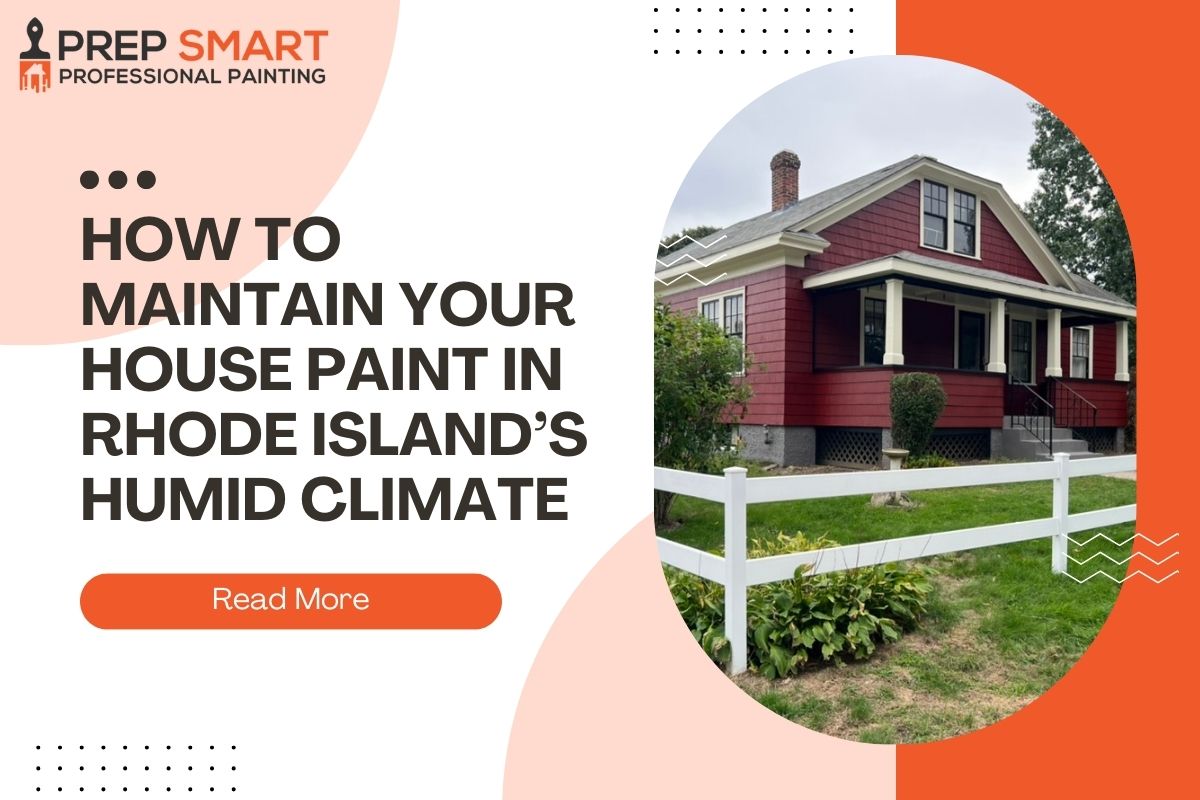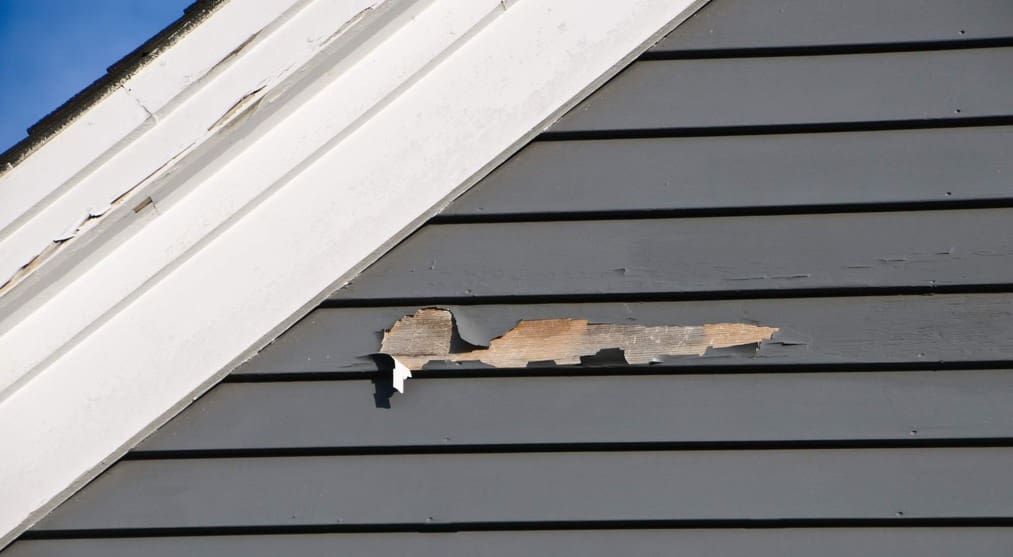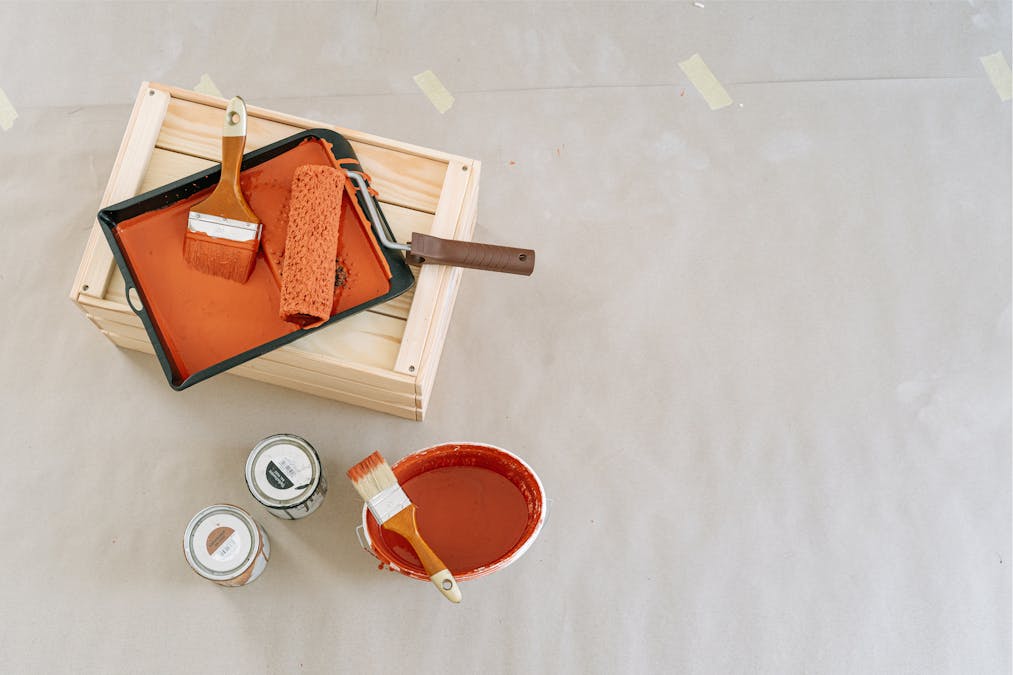
How to Maintain Your House Paint in Rhode Island’s Humid Climate
Rhode Island’s Climate
Rhode Island experiences a humid continental climate, marked by four distinct seasons. Summers are typically hot and humid, with average temperatures ranging from 70°F to 80°F, occasionally reaching the mid-90s. Winters are cold, with temperatures often falling below freezing, especially in inland areas. Snowfall is common, with an average annual accumulation of around 35 inches. The state also receives substantial rainfall, averaging about 45 inches per year, spread fairly evenly across all seasons. This combination of high humidity, significant temperature fluctuations, and abundant precipitation creates a challenging environment for exterior house paint.
Effects of Humidity on House Paint
High humidity levels can severely affect house paint. Moisture can penetrate the paint film, causing several issues:
- Blistering and Peeling: When moisture gets trapped under the paint layer, it can cause the paint to bubble and eventually peel away from the surface. This is particularly common in areas with poor ventilation or where water accumulates. Painting in high humidity increases the likelihood of these issues.
- Mold and Mildew Growth: Humid conditions provide an ideal environment for mold and mildew. These fungi can grow on painted surfaces, especially in shaded or poorly ventilated areas, leading to discoloration and degradation of the paint. Humidity for painting must be managed to prevent such growths.
- Reduced Adhesion: Persistent moisture can weaken the bond between the paint and the underlying surface, leading to flaking and chipping. Humidity when painting should be low to ensure strong adhesion.
- Efflorescence: In masonry surfaces, moisture can dissolve salts within the materials. When this moisture evaporates, it leaves behind a white, powdery residue that can mar the appearance of painted surfaces. Proper humidity for spray painting can help mitigate this issue.
Importance of Climate Consideration in Paint Selection
Selecting the right paint for a humid climate like Rhode Island’s is essential for ensuring the longevity and appearance of your home’s exterior. Paints formulated for high-humidity environments offer several advantages:
- Moisture Resistance: These paints are designed to create a barrier that prevents moisture from penetrating the paint film, reducing the risk of blistering and peeling. Humidity and painting considerations are important in selecting such paints.
- Mildew Resistance: Many paints for humid climates include mildewcides, which inhibit the growth of mold and mildew on the painted surface.
- Durability: High-quality, climate-appropriate paints are formulated to withstand temperature fluctuations and UV exposure, ensuring they remain intact and vibrant longer. Paint and humidity must be considered to ensure durability.
- Breathability: Some paints are designed to allow trapped moisture to escape, reducing the risk of damage without compromising the paint’s protective qualities.
By considering these factors when selecting paint, homeowners in Rhode Island can protect their homes from the adverse effects of the state’s climate, ensuring their properties remain attractive and structurally sound for years to come. Prepsmart painting is an excellent option to consider for this purpose.
Choosing the Right Paint for Humid Climates
Types of Paint Suitable for Humid Conditions
When selecting paint for a humid climate like Rhode Island’s, certain types of paint perform better due to their inherent properties. These include:
- Acrylic Latex Paint: This water-based paint is highly durable and flexible, making it ideal for humid environments. It has excellent adhesion, resists fading, and can expand and contract with temperature changes without cracking. This type of paint is perfect for painting with humidity in mind.
- Acrylic Enamel Paint: Combining the durability of enamel with the flexibility of acrylic, this type of paint provides a hard, glossy finish that is resistant to moisture and wear, making it suitable for high-humidity areas. Painting in high humidity conditions benefits from the resilience of acrylic enamel.
- Elastomeric Paint: Known for its superior waterproofing capabilities, elastomeric paint can bridge small cracks and prevent moisture from penetrating the surface. It is particularly useful for masonry and stucco surfaces, making it an excellent choice for high humidity paint applications.
Features to Look for in Paint
When choosing paint for humid climates, certain features can significantly increase performance and longevity:
- Moisture Resistance: Look for paints specifically labeled as moisture-resistant or designed for humid environments. These paints form a barrier against water penetration, reducing the risk of blistering and peeling. This is importantfor painting in humidity.
- Mildew Resistance: Paints with added mildewcides help prevent the growth of mold and mildew on the painted surface, keeping the exterior clean and reducing maintenance efforts. This feature is essential for humidity and painting.
- UV Protection: Paints with UV blockers protect against sun damage, which can cause fading and deterioration. This feature is important for maintaining color vibrancy and surface integrity, ensuring your paint withstands weather painters.
- Breathability: Breathable paints allow trapped moisture to escape, preventing condensation and the resulting damage. This is particularly important for older homes or those with less effective moisture barriers, optimizing humidity for painting.
By selecting the right type of paint with the necessary features and choosing from reputable brands, homeowners can ensure their exteriors remain protected and visually appealing despite the challenges posed by Rhode Island’s humid climate. Prepsmart painting is a wise choice for achieving these benefits.
Preparation and Application Tips
Surface Preparation
Proper surface preparation is important for ensuring the longevity and adhesion of paint, especially in humid climates. The key steps include:
Cleaning and Priming:
- Cleaning: Begin by thoroughly cleaning the surface to remove dirt, mold, mildew, and any loose or flaking paint. Use a pressure washer for large areas or a scrub brush and a cleaning solution for smaller areas. A solution of water and trisodium phosphate (TSP) is effective for removing grime and mildew. This step is vital when painting with high humidity as it ensures a clean, moisture-free surface.
- Priming: After cleaning, allow the surface to dry completely. Apply a high-quality primer designed for the surface material (e.g., wood, masonry, metal). Primers help seal the surface, providing a uniform base for the paint and improving adhesion. This is especially important for paint in humidity conditions.
- Cleaning: Begin by thoroughly cleaning the surface to remove dirt, mold, mildew, and any loose or flaking paint. Use a pressure washer for large areas or a scrub brush and a cleaning solution for smaller areas. A solution of water and trisodium phosphate (TSP) is effective for removing grime and mildew. This step is vital when painting with high humidity as it ensures a clean, moisture-free surface.
- Priming: After cleaning, allow the surface to dry completely. Apply a high-quality primer designed for the surface material (e.g., wood, masonry, metal). Primers help seal the surface, providing a uniform base for the paint and improving adhesion. This is especially important for paint in humidity conditions.
Repairing Damages:
- Filling Cracks and Holes: Use appropriate fillers or caulk to fill any cracks, gaps, or holes in the surface. For wood, use exterior wood filler; for masonry, use a suitable patching compound. Ensuring the surface is smooth and intact is essential for effective painting with humidity.
- Sanding: Once the filler has dried, sand the repaired areas to smooth them out and ensure a uniform surface for painting. Proper sanding helps create a smooth, adherent surface, important for high humidity paint applications.
By thoroughly cleaning, priming, and repairing the surface, homeowners can ensure their paint adheres properly and lasts longer, even in the challenging conditions of Rhode Island’s humid climate.
Proper Application Techniques
Using the right application techniques is essential for achieving a durable and attractive finish. Consider the following:
Tools and Equipment:
- Brushes and Rollers: Use high-quality brushes and rollers designed for exterior use. For large, flat surfaces, rollers are efficient, while brushes are ideal for edges and detailed areas. These tools ensure the paint is applied evenly and adheres well, important for painting in high humidity.
- Sprayers: For large projects or surfaces with intricate details, consider using a paint sprayer for a smooth and even application. Humidity for spray painting must be managed carefully to ensure the paint does not dry too quickly or too slowly.
Optimal Weather Conditions for Painting:
- Temperature: Paint in temperatures between 50°F and 85°F for best results. Extreme temperatures can affect paint adhesion and drying times. Exterior painting temperature and humidity are key factors to consider.
- Humidity: Avoid painting on very humid or rainy days. Ideally, the humidity should be below 60% to ensure proper drying and curing. High humidity when painting can lead to issues like blistering and poor adhesion.
Best Practices for Different Surfaces
Different materials require specific considerations to achieve the best results:
Wood:
- Ensure the wood is dry and free of any previous peeling paint. This is important for effective painting in humidity.
- Apply a primer specifically designed for wood to seal the surface and prevent tannin bleed-through. Proper priming helps in dealing with humidity for painting.
Masonry:
- Clean thoroughly to remove any efflorescence (white powdery residue). Proper cleaning ensures that paint in humidity adheres well.
- Use a masonry primer to help the paint adhere properly and to seal the porous surface, which is especially important for painting with high humidity.
Metal:
Remove any rust or old paint using a wire brush or sandpaper. This step is essential to prepare the surface for high humidity paint.
Apply a rust-inhibiting primer to prevent future corrosion. This ensures that the paint remains durable despite humidity and painting challenges.
Maintenance Tips to Prolong Paint Lifespan
Regular Inspections
Frequent inspections of your home’s exterior can help identify potential issues before they become significant problems. Key aspects of regular inspections include:
- Visual Check: Look for signs of peeling, blistering, or cracking paint. Inspect areas that are particularly vulnerable to moisture, such as around windows, doors, and eaves. This is especially important in humid climates where moisture can quickly lead to paint and humidity related problems.
- Structural Issues: Check for any structural damage that could affect the paint, such as wood rot, loose siding, or damaged masonry. Addressing these issues promptly can prevent further damage and ensure the longevity of the paint job, important for painting in high humidity areas.
Cleaning Techniques
Keeping the exterior clean is essential for maintaining the paint’s appearance and preventing damage. Effective cleaning methods include:
- Products and Tools for Cleaning: Use a mild detergent or a specialized exterior house cleaner to remove dirt, grime, and mildew. A soft-bristle brush or sponge can help scrub away stubborn spots without damaging the paint. This is particularly important in humid climates to prevent issues related to humidity and paint.
- Cleaning Frequency: Aim to clean the exterior at least once a year, preferably in the spring or fall when the weather is mild. In humid climates, additional cleanings may be necessary to prevent mold and mildew buildup. Regular cleaning helps maintain the integrity of the paint and is important for managing paint in high humidity conditions.
Touch-Up Procedures
Regular touch-ups can help maintain the integrity of the paint and prolong its lifespan. Steps for effective touch-ups include:
- Identifying Areas for Touch-Up: Look for small areas where the paint has chipped, peeled, or faded. These spots are often found around high-traffic areas and places exposed to harsh weather conditions. Addressing these issues promptly is essential in high humidity environments to prevent further deterioration.
- Matching Paint Colors: Use leftover paint from the original project for touch-ups to ensure an exact color match. If you don’t have any leftover paint, take a sample to a paint store to match the color accurately. This step ensures consistency and helps maintain the aesthetic appeal of the painted surface, even in challenging humidity and painting conditions.
- Application: Clean the area thoroughly, sand lightly to create a smooth surface, and apply the touch-up paint with a small brush. Allow it to dry completely before assessing whether an additional coat is necessary. Proper application techniques are important when painting with humidity to ensure the touch-ups blend seamlessly with the existing paint.
Common Problems and Solutions
Blistering and Peeling
Blistering and peeling are common issues in humid climates, where moisture can get trapped under the paint layer.
Causes:
- Trapped Moisture: High humidity levels can cause moisture to get trapped under the paint, leading to blistering. This is a frequent issue when painting with humidity is not properly managed.
- Poor Surface Preparation: Not properly cleaning or priming the surface can result in poor adhesion. This is important to avoid problems related to humidity and paint.
- Painting in Humid Conditions: Applying paint when humidity is high or when the surface is damp can prevent proper curing. Humidity for painting must be below 60% to ensure effective results.
Prevention and Repair:
- Prevention: Ensure thorough cleaning and priming of surfaces before painting. Avoid painting on humid or rainy days. Proper timing and preparation are essential to handle painting in high humidity conditions.
- Repair: Scrape off the blistered or peeling paint, sand the area smooth, clean it thoroughly, and apply a primer before repainting with a high-quality paint designed for humid conditions. Using prepsmart painting techniques can help ensure better adhesion and durability.
Mold and Mildew
Mold and mildew thrive in humid environments and can cause discoloration and damage to painted surfaces.
Identification:
- Appearance: Mold and mildew often appear as black, brown, or green spots on the paint surface. This is a common problem when painting with high humidity.
- Smell: A musty odor can indicate mold or mildew presence, which is frequently an issue related to humidity and paint.
Treatment and Prevention:
- Treatment: Clean the affected area with a mixture of water and bleach (1:3 ratio) to kill the mold and mildew. Rinse thoroughly and allow the area to dry completely. This treatment is essential for maintaining the integrity of the paint in high humidity conditions.
- Prevention: Use mildew-resistant paint, ensure proper ventilation around the house, and trim back vegetation that can trap moisture against the walls. These measures are important for painting in humidity to prevent mold and mildew growth.
Fading and Discoloration
Fading and discoloration are often caused by prolonged exposure to sunlight and the elements.
Causes:
- UV Exposure: Ultraviolet rays from the sun can break down the pigments in paint, causing it to fade. This issue is exacerbated in humid climates where the combination of moisture and sunlight can accelerate deterioration.
- Poor-Quality Paint: Lower-quality paints may not have the same level of UV protection and can fade more quickly. Selecting the right humidity for painting conditions is important to ensure paint longevity.
Solutions:
- Use High-Quality Paint: Select paints that have UV-resistant properties and are formulated for exterior use. These paints are more resilient to both sunlight and humidity and paint challenges.
- Regular Maintenance: Periodically clean the surfaces to remove dirt and pollutants that can accelerate fading. Regular maintenance helps maintain the paint’s appearance and durability, even when painting in high humidity environments.
When to Seek Professional Help
Assessing the Scope of the Project
Deciding whether to managea painting project yourself or hire professionals depends on several factors:
- Size of the Project: Large projects, such as painting an entire house, can be time-consuming and physically demanding. Professionals have the manpower and equipment to complete such tasks efficiently, especially in challenging conditions like painting with high humidity.
- Complexity: Projects involving intricate details, hard-to-reach areas, or significant repairs may be better handled by experts who have the necessary skills and tools. Professional painters are experienced in managing painting in humidity, ensuring optimal results.
- Condition of the Surface: If the surface is significantly damaged or has extensive mold, mildew, or peeling paint, professional intervention might be necessary to ensure proper preparation and application. Dealing with humidity and paint issues, such as mold and blistering, often requires specialized knowledge and equipment.
Benefits of Hiring Professionals
Hiring professional painters offers several advantages:
- Expertise and Experience: Professionals bring years of experience and expertise, ensuring high-quality work and adherence to best practices. They are skilled in dealing with humidity and painting challenges, which is important for achieving a durable finish.
- Proper Equipment: Professionals have access to specialized tools and equipment that can provide better results and save time. This is especially beneficial when painting in high humidity, where precise application and quick drying are essential.
- Time and Convenience: Hiring experts can save you significant time and effort, allowing you to focus on other tasks or simply enjoy the results without the hassle. Prepsmart painting services can efficiently handle the workload, ensuring your project is completed on time.
- Warranty and Insurance: Many professional painters offer warranties on their work and are insured, providing peace of mind and protection against potential issues. This is particularly important for ensuring the longevity of your paint job in humid climates.
Finding Reliable Painting Services in Rhode Island
To find reliable painting services in Rhode Island, consider the following steps:
- Research and Reviews: Look for painting companies with positive reviews and testimonials. Websites like Yelp, Google Reviews, and Angie’s List can provide insights into customer satisfaction. This research can help you find professionals experienced in painting in high humidity conditions.
- Ask for Recommendations: Seek recommendations from friends, family, or neighbors who have had positive experiences with local painters. Personal referrals can be invaluable in finding trustworthy services that understand the challenges of painting with humidity.
- Verify Credentials: Ensure the company is licensed and insured. Check for any certifications or affiliations with professional organizations, which can indicate a commitment to quality and professionalism. This is particularly important for addressing issues related to humidity and painting.
- Get Multiple Quotes: Obtain quotes from several painting contractors to compare prices and services. Be wary of significantly low bids, as they may indicate subpar materials or workmanship. Getting multiple quotes can also help you assess how well each company can handle high humidity paint requirements.
- Check Past Work: Ask to see examples of previous projects or visit completed works to assess the quality and style of their work. Reviewing past projects can give you confidence that the painters are capable of managing painting in high humidity environments effectively.
Seasonal Painting Guide
Best Times of Year for Painting in Rhode Island
Choosing the right time to paint can significantly impact the outcome and durability of your project. Consider the following seasonal recommendations:
- Spring: Ideal for exterior painting as temperatures are moderate and humidity levels are typically lower. Aim for late spring to avoid unpredictable early spring weather. This period offers optimal humidity for painting, ensuring proper drying and adhesion.
- Summer: Early summer is a good time to paint, but avoid peak summer heat and humidity. Mornings and late afternoons are often the best times to paint during this season. Managing humidity and painting conditions carefully during this time is important for achieving a durable finish.
- Fall: Early fall offers stable weather conditions with cooler temperatures and lower humidity, making it an excellent time for painting. The lower humidity when painting in early fall helps in achieving a smooth, long-lasting finish.
- Winter: Generally, not recommended for exterior painting due to cold temperatures and potential for snow and ice. However, winter can be a good time for interior painting projects. Ensuring proper humidity for painting indoors during winter is essential to avoid issues with paint curing.
Seasonal Challenges and Solutions
Each season presents unique challenges for painting projects. Understanding these and preparing accordingly can ensure better results:
Winter:
- Challenges: Cold temperatures can cause paint to thicken and not adhere properly. Limited daylight hours can also be a constraint, making it difficult to complete exterior projects.
- Solutions: Focus on interior projects, ensure adequate ventilation, and use paints designed for lower temperatures if necessary. This helps maintain the quality of painting in high humidity indoor environments.
Spring:
- Challenges: Early spring can be unpredictable with fluctuating temperatures and rain, which can interfere with paint application and drying.
- Solutions: Wait until late spring for more consistent weather and always check the forecast before starting a project. This timing helps avoid issues related to humidity and paint.
Summer:
- Challenges: High heat and humidity can affect drying times and paint adhesion, making it difficult to achieve a smooth finish.
- Solutions: Paint during cooler parts of the day, ensure surfaces are dry, and use paints specifically formulated for high temperatures. Managing humidity for painting during summer is important for achieving the best results.
Fall:
- Challenges: Early frost and shorter days can impact painting schedules, potentially leading to rushed or incomplete projects.
- Solutions: Start projects early in the fall, monitor weather conditions, and aim to finish before temperatures drop too low. Ensuring optimal humidity for spray painting and other techniques in fall can improve durability and finish.
Conclusion
Maintaining your house paint in Rhode Island’s humid climate requires a comprehensive approach that includes understanding the local climate, choosing the right paint, proper preparation and application, and ongoing maintenance. Rhode Island’s humid, variable climate poses unique challenges to exterior paint, making it essential to select moisture-resistant and mildew-resistant paints specifically formulated for such conditions. Thorough surface preparation, including cleaning, priming, and repairing any damages, is negativeto ensure good paint adhesion and longevity. Painting during optimal weather conditions, typically in late spring, early summer, or early fall, can significantly increase the durability and appearance of the paint.
Regular inspections, cleaning, and touch-ups are necessary to maintain the paint’s integrity and address common issues like blistering, mold, and fading. When faced with large, complex, or damaged projects, hiring professional painters can provide high-quality results and save time and effort. Prepsmart painting can offer expert services and advice to ensure the best outcomes for your painting projects. Considering environmental factors, such as using eco-friendly paints and disposing of materials responsibly, can further reduce your environmental impact and contribute to a healthier living environment. By following these guidelines and utilizing available resources, homeowners can effectively maintain their house paint, ensuring their homes remain attractive and well-protected against the challenges posed by Rhode Island’s humid climate.
FAQs
Why is proper surface preparation crucial before painting in humid climates?
Proper surface preparation ensures the paint adheres well and lasts longer. Cleaning removes dirt, mold, and loose paint, while priming creates a uniform base and seals the surface.
What cleaning solutions are effective for preparing surfaces in humid conditions?
A solution of water and trisodium phosphate (TSP) is effective for removing grime and mildew, ensuring a clean, moisture-free surface before painting.
What are the benefits of using elastomeric paint in humid climates?
Elastomeric paint offers superior waterproofing capabilities, can bridge small cracks, and prevents moisture from penetrating the surface, making it ideal for masonry and stucco in humid conditions.
How often should you inspect your home’s exterior paint for signs of damage in humid climates?
Regular inspections should be conducted at least once a year to identify issues like peeling, blistering, or mold growth, allowing for timely maintenance and touch-ups.
What tools are recommended for applying paint in high humidity conditions?
High-quality brushes and rollers designed for exterior use are recommended for even application, while sprayers can be used for large projects or intricate surfaces, ensuring smooth coverage.
How can seasonal changes in Rhode Island impact your painting project?
Spring and early fall offer ideal conditions with moderate temperatures and lower humidity, while summer heat and winter cold can affect paint adhesion and drying times.
What additional steps can be taken to prevent mold and mildew growth on painted surfaces?
Using mildew-resistant paint, ensuring proper ventilation, and trimming vegetation that traps moisture can help prevent mold and mildew growth on painted surfaces.
Lorem ipsum dolor sit amet, consectetur adipiscing elit. Ut elit tellus, luctus nec ullamcorper mattis, pulvinar dapibus leo.






